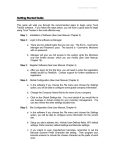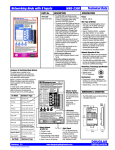Download Product Requirements Definition
Transcript
WIR-3110 Infrared Setting Unit User Manual for Diversa Dual Technology Sensors Douglas Lighting Controls www.douglaslightingcontrols.com Page 1 July 20, 2015 R1.0 1. INTRODUCTION 1.1. GENERAL DESCRIPTION The WIR-3110 Infrared setting unit interfaces with the Diversa Occupancy sensors. The Diversa Occupancy sensors use IR technology to allow touchless programming. Douglas Lighting Controls www.DouglasLightingControls.com Page 2 August 25, 2015 Tech Support: 1-877-873-2797 2. FEATURES AND OPTIONS Menu Navigation A. Menu Number B. Menu Title C. Cursor Send/Receive Send/Receive range varies for each sensor form factor. WOS type sensors are designed to have a very short range; hold right up to the sensor lens. WOR/WOW type sensors are designed to have a significantly longer range. A WiFi symbol will appear while the sensor is Reading or Writing. 1. Write (Push UP) 2. Read (Push DOWN) 3. Clear (Push RIGHT) 4. Off* (Push LEFT) *programmer will turn off automatically after one minute of no activity. 2.1. Sensor Information 1) Model Number: Full Model number indicating options. Note, lens type is not shown. 4) Setting (Read only): This field indicates if the device is setup to use either the on-board dip switch values or the IR settings. 2) Hardware Version 5) 3) Firmware Version IR Lock: If “Locked” the Setting DIP for configuration is ignored and only the IR settings are used. Douglas Lighting Controls www.DouglasLightingControls.com Page 3 August 25, 2015 Tech Support: 1-877-873-2797 2.2. Occupancy Setting Menu 1 1) Occupancy Sensor Mode: The “WO” Diversa sensors can be setup to operate like a “WV” Diversa sensors by selecting between “Occupancy” or “Vacancy” modes. 2) Vacancy Time: - Auto - 30 Sec - 1 minutes - 5 minutes - 10 minutes - 20 minutes - 30 minutes - 40 minutes - 60 minutes - 90 minutes - 120 minutes 2.3. 3) Smart Sense: The timer keeps the ADI-Voice on after vacancy timeout, allowing the lights to be turned on with ADI-Voice detection. The selected time is used as the mid range for the adaptable. - 15 sec - 30 sec - 1 minute - 1:30 minute - 2 minutes - 3 minutes - 4 minutes Occupancy Setting Menu 2 1) Passive Infrared (PIR) Sensitivity: Disabled Low Medium High 3) Walk-Thru Mode: When enabled, this feature turns the lights off after 3 minutes if no occupancy detection occurs after the first 30 seconds after initial turn on. 2) Accurate Detection Intelligence (ADI) Voice Sensitivity: Disabled Low Medium High 4) Indicating LED: If preferred, this allows you to disable the motion and ADI-Voice indicating LEDs. Douglas Lighting Controls www.DouglasLightingControls.com Page 4 August 25, 2015 Tech Support: 1-877-873-2797 2.4. Feature Enabling Menu 1) Switching Feature: Enable or Disable on-board switch. 3) 0-10V Dimming: If equipped, enable or disable the 010V dimming output. 2) Photo ON/OFF Feature: If equipped, enable or disable the photocell feature. This feature enables/disables lights if adequate natural light is present. 4) Photo Controlled Dimming: If equipped, allow the 0-10V dimming & photo options, enabling it’s function will allow the 0-10V output to be controlled by the photocell or at the fixed dim level; see menu 9. Douglas Lighting Controls www.DouglasLightingControls.com Page 5 August 25, 2015 Tech Support: 1-877-873-2797 2.5. Switch Setting Menu 1 Use this menu to configure dual pole sensors as multi-level lighting (sequencing) sensors. 1) Sequences (2-Pole): Once configured using WIR-3110 with each press of the override button the Diversa sensor steps through the sequence, as per table below: 00 = Both poles off (START) 10 = Primary pole off, secondary pole on 11 = Both poles on 01 = Primary pole on, secondary pole off RPT = Repeat Start 1st Press 2nd Press 3rd Press 4th Press 00 01 10 11 00 00 10 11 00 10 00 01 11 00 01 00 11 00 11 00 00 01 00 01 00 00 00 00 00 00 2) Alternating Primary (2-Pole): When enabled, the primary pole will alternate for even lamp wear, every time occupancy is detected (does not apply to override button). 3) Disable Mode The sensor can be disabled by applying 24VAC from the source on the Sensor Link wire. This option is to determine what action is to be performed. - OFF - 10 - 01 - 11 - – – (As-is) The first level is activated by the occupancy signal or switch if it is set to vacancy. Douglas Lighting Controls www.DouglasLightingControls.com Page 6 August 25, 2015 Tech Support: 1-877-873-2797 2.6. Switch Setting Menu 2 Use this menu to configure override button functionality. 1) Pole 1 - Override: - ON/OFF - ON Only - OFF Only Douglas Lighting Controls www.DouglasLightingControls.com 2) Page 7 Pole 2 - Override: - ON/OFF - ON Only - OFF Only August 25, 2015 Tech Support: 1-877-873-2797 2.7. 1) 2) Photo Setting Menu 1 Ranges: Ceiling Mount 0-800 Lux Wall Mount 0-800 Lux Wall Switch 0-800 Lux Photo Setpoint High For switching: When the light level is lower than this setting it will turn the lights ON when in ON/OFF photo mode. 3) Photo Setpoint Low For switching: When the light level is higher than this setting it will inhibit the lights from turning ON or turn them off depending on the “Photo Mode”. Douglas Lighting Controls www.DouglasLightingControls.com Page 8 Photo Capture & Temporary Dim These two functions are used to set the photo set points automatically. Use the temporary (30 Sec) dim to set the desired maintained light level. Then send a “Photo Capture” to read the light level. August 25, 2015 Tech Support: 1-877-873-2797 2.8. Photo Setting Menu 2 1) Photo Control: - Disabled - Pole 2 Only - Both Poles 3) Switch Inhibit*: When enabled, it will inhibit the switch from turning the light on if there is sufficient ambient light detected. Photo OFF setpoint. 2) Photo Type*: Inhibit Only: If occupancy is detected AND there is a deficiency of natural light (as determined by photo setpoint off), the output is triggered on. Once on, the output remains on until a vacancy condition is determined by expiration of the vacancy timer. An increase in natural light will not force the lights off. ON/OFF Control: If occupancy is detected AND there is a deficiency of natural light (as determined by a programmable set point), the output is triggered on. Once on, the output remains on until a vacancy condition is determined by expiration of the vacancy timer. An increase in natural light will allow the lights to turn off and as the ambient light level drops the lights will turn on automatically. *If Photo is disabled on Menu 4, the following features are not applicable: Switch Inhibit Photo Type Douglas Lighting Controls www.DouglasLightingControls.com Page 9 August 25, 2015 Tech Support: 1-877-873-2797 2.9. Dimming Setting Menu 1) Dimming Maximum Limit (%) & Fixed Dimming Output 2) Dimming Minimum Limit (%) 3) Unoccupied Function: - Minimum Dim Only - Relay OFF 3) Test Mode: When activated, the sensor options are temporarily changed for quick reaction times (Timeout: 5 sec, Smart-Sense: 5 sec) and ADI-Voice enabled. This will drop out to normal mode after 30 minutes 2.10. Miscellaneous Setting Menu 1) Auxiliary Contact Mode (-R option): Indicate Occupancy Indicate Output Signal 2) RESET: All Settings Photo Settings Audio Settings None Douglas Lighting Controls www.DouglasLightingControls.com Page 10 August 25, 2015 Tech Support: 1-877-873-2797



















